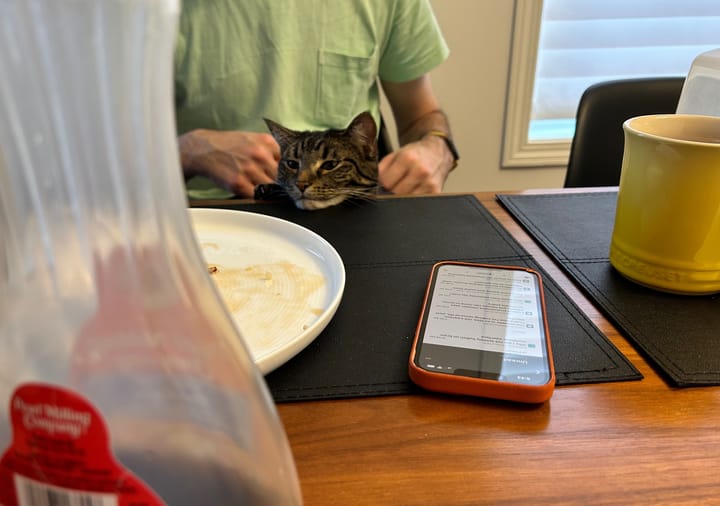How to Live at 80 Percent
When things are smooth, it's ok to be at 100 percent. But when they change, things start to break down. Learn how to live at a more manageable 80 percent.

I recently read Big Feelings: How to Be Okay When Things Are Not Okay, by Liz Fosslien and Mollie West Duffy. You might recognize the art from their Instagram account, @lizandmollie, or even from around the internet (including several of my past articles). They illustrate many of the challenges of burnout, perfectionism, and self-doubt.
One of the helpful concepts that came up in the book was what it means to live at 80 percent. They explained:
“If everything is running smoothly, piling your plate with to-dos can work. But then you get sick or have to support a family member, or your boss quits, and suddenly you go from 100 to 120 percent and your life melts into an unmanageable nightmare.”
If you are instead living at 80 percent, you have space to roll with whatever inevitable challenges come up.
Makes sense, right?
So what does living at 80 percent look like in practice? Let’s dig in a bit.
The consequence of living at 100 percent (or more)
First off, let’s talk about consequences. The consequence of living at 100 percent or more, is burnout.
In my article, Why Does Burnout Happen? You Do It To Yourself, I talk about the role you play in your own path to burnout. While there will be circumstances outside your control that contribute to burnout, often it is your decisions that lead the way.
These decisions include when you:
- Skip meals or choose to eat poorly
- Stay up too late and don’t get enough sleep
- Don’t take breaks
- Don’t exercise or move your body
- Say yes to things out of guilt or obligation
- Overbook your schedule
- Put yourself last over and over
For a time you absolutely can push hard, work late, and take on extra commitments. Sometimes that’s ok and even required. For a little while it will be fine. You will juggle all the balls and do all the things! But eventually, you will get thrown one-too-many (or five or twenty-five or fifty-five-too-many) balls and no matter how fast you juggle you will start dropping them:
- You will start to feel overwhelmed.
- It will get hard to prioritize because everything will seem important.
- Things will get missed and you will not be able to do things up to your usual standards.
- You will feel bad about what’s not getting done or the people you are neglecting.
- Even worse, you will start to feel resentment and apathy.
If this goes on long enough, you will be burnt out.
So how do we prevent living at or beyond 100 percent?

How to live at 80 percent
First off, there is value in acknowledging the drive to fill up every moment of our lives. The combination of:
- The pervasive idea of hustle, hustle, hustle if you want to “succeed”
- The endless availability of distractions and numbing in social media and streaming
- The way rest has been so closely tied to “wasting time”
Often keeping space feels fraught with anxiety about what you should be doing. It’s a battle to let go of the drive to be “productive” all the time and the guilt that goes with it.
To be blunt, it takes work and intention to live at 80 percent. But it’s worth it so you can more easily weather the ups and downs that will inevitably disrupt your life.
Here are 3 ways to help you live at 80 percent:
1. Pause and evaluate
It’s easy to get caught up in the rhythms of life, settled in routines that are punctuated by hopping from one fire to the next. Time passes and you wonder where it went and how you got so far down the road of burnout.
It can feel sudden, but when you slip over your 100 percent capacity it's usually been building for some time. Burnout is often a case of death by a thousand cuts, or in this case, burnout by a thousand unintentional choices.
To stop yourself from going down the road of burnout, you have to notice when things are starting to build so you can make different choices and change course:
- Take a break
- Eat something
- Move your body
- Say no to a commitment
- Think about what is motivating your decisions
Pause and evaluate, instead of acting on autopilot.
You can do this through:
1. Daily Reflection
Y’all know I love daily reflection. I have written at length about it and how it is foundational to an intentional life. Each day, take a few minutes to ask yourself: What went well, what was tricky, and what would I do differently next time? (of whatever variation of daily reflection you prefer).
2. Journaling
Journaling takes a bit more time and effort than daily reflection but is a powerful way to process your thoughts and feelings, particularly when things are challenging. I personally have a Google Doc that I journal in when I am working through tough emotions. I have several clients who also like the feel of pen and paper. The format doesn’t matter, only that you are taking a step back to think through what’s happening in your life.
3. Meditation
I am new to meditation, having tried and failed at it several times over the years. But as someone who struggles to be present, even just 10 minutes a day before I start work has been an effective way to pause each day and check in with myself. I use the Waking Up app for guided meditations, but there are tons of options out there.
2. Reset your expectations
Have you ever ended a day disappointed that you didn’t get to the 15 things on your to-do list? Have you ever felt like you can’t seem to get as much done each day as you “should”?
These feelings are usually the result of unrealistic expectations you put on yourself for what is actually possible in a given day or week. You forget that you will never have a solid, uninterrupted, 8-hour work day. After normal routines (sleep, hygiene, eating, childcare, commuting), meetings, and interactions with clients, colleagues, staff, family, and friends…
Suddenly your available time looks a bit different.
Map out your ideal week
The very first activity I do with all of my clients is to help them map out their normal routines, imagine their ideal week, and then compare it to their actual week. They are always shocked at the true amount of time left each day.
Reset your expectations for what is reasonable, given what is happening on a particular day or week. Ask yourself:
- What does an 80 percent week look like?
- What fits and what doesn’t?
- Where can I leave myself space?
3. Create and stick to your boundaries
Fosslien and West share the reminder,
“you have to set and stick to your own boundaries. No one else is going to draw them for you.”
It’s when you let your boundaries slip, say yes when you should say no (or not now), and take on more and more, that your capacity creeps up and up to past your 100 percent.
Read more about boundary setting around email, meetings, and availability in some of my past articles.
Help stick to your boundaries through commitment rules
One way to help facilitate more thoughtful yeses and easier noes are through commitment rules. A commitment rule is a way of defining what you will or will not do in a given situation.
Author Ryan Holiday says,
“People respect rules, and they accept that it’s not you rejecting the offer, request, demand, or opportunity, but the rule allows you no choice”.
Some examples of commitment rules include:
- Don’t open your laptop after a certain time of day
- Sleep on any commitments before you say yes (or no)
- Protect a certain day/night
- Take meetings only on certain days or at certain times
- Only check your social media once a day
These are boundaries that will help you live at 80 percent. As Fosslien and West say,
“behind every no is a deeper yes, even if that yes is just to yourself”.

Decide what living at 80 percent means to you
There will be seasons of your life that demand more from you than others. Some will be short, days and weeks of a work project, a bad cold going through your household, or moving. Others will be long, months or years of raising young kids, supporting someone through serious illness, or going back to school.
As Fosslien and West put it,
“Your capacity is also going to be different from everyone else’s. Your friends, your coworkers, and even your partner may not share your burnout triggers.”
You have to decide for yourself, where you can make space in your life, in your circumstances, and it will change over time.
How I live at 80 percent
To me, living at 80 percent means:
- I protect my Friday nights and Saturday mornings to spend time with my husband. This means that we always have time just for us.
- I generally don’t book meetings on Mondays or Fridays. This means if I have a meeting I need to adjust or don’t have space for on one of the other days of the week, I have some flexibility.
- I schedule a maximum of two evening commitments per week.
- I schedule a maximum of three meetings per day
- I exercise every day. I don’t skip it, I don’t schedule over it, I protect the time and do it.
- I do a daily reflection each evening before bed to think about what happened, how I feel, and anything I need to pay attention to.
Is my life always at 80 percent? Absolutely not. Do these boundaries and activities help? They absolutely do.
Living at 80 percent is an aspirational goal. The reality is things will fluctuate up and down all the time. The key is to be conscious of when you are starting to get overwhelmed and overloaded and pay attention to the signs that you are ticking up closer to 100 percent. Reset your expectations for what is possible on a given day or week and stay true to your boundaries.
Living at 80 percent is not about being unambitious, but rather setting yourself up for success when life happens because it always does!
Need help getting your life closer to 80 percent? I can help!
Share
Ashley Janssen

Productivity consultant, writer, speaker, serial entrepreneur, chaos calmer, introvert, cat-lady. Lover of books, fitness, old fashioned’s, basketball, and video games.
Follow me on
Twitter
or
LinkedIn.
Hire me for
1 on 1 productivity consulting
or
speaking.
Related articles

How to Stay Productive When Things Calm Down

The Pursuit of Calm


Comments ()